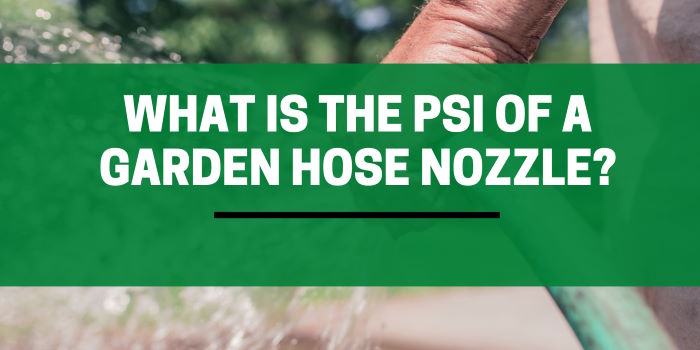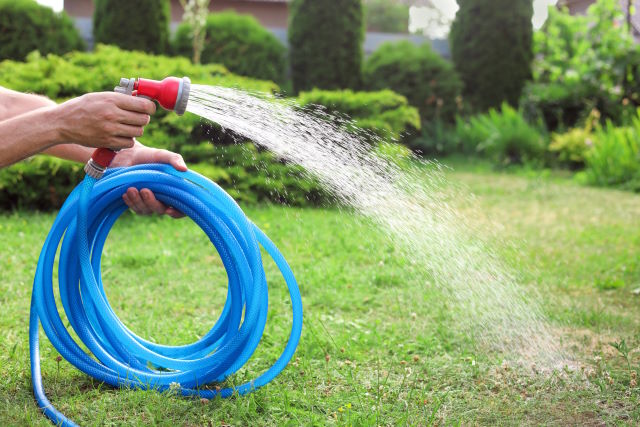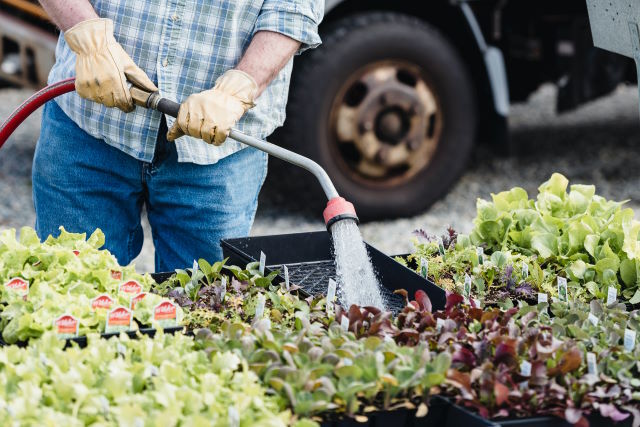
Pressure per Square Inch, or PSI, is a common unit of pressure used in various systems, including the water system of your garden hose.
It denotes the force applied to one square inch of an area. In essence, the higher the PSI, the more force is exerted on that small area.
Contents
Role of PSI in Garden Hose Nozzles
In the context of garden hose nozzles, PSI plays a significant role in determining the force of the water that’s discharged. It’s like the power behind the water’s punch. Your delicate flowers might require a gentle shower with lower PSI, while your driveway might need a powerful stream with a higher PSI.

The PSI directly influences the water flow rate from your garden hose nozzle. With a high-pressure hose, you’re likely to experience a faster and more powerful water flow, making it ideal for tasks that require a strong spray, like cleaning surfaces or reaching distant plants.
Typical Nozzle PSI
The water pressure from a spigot in an average home ranges between 40 and 90 PSI. W
With the right hose nozzle, you can boost that up to an impressive 300 PSI!
However, it’s important to note that several factors can influence the PSI output of your hose nozzle. These factors include your home’s water pressure, the length of the hose leading up to the nozzle, and the nozzle itself.
Typically, most consumer-grade hose nozzles can deliver a maximum output of 100 to 250 PSI. In comparison, fire hoses can pack a punch with around 300 PSI. Don’t worry though, most houses provide enough pressure to prevent any significant drop in hose pressure until the hose length exceeds 100 feet.

To give you a better idea, we’ve put together a chart below that outlines the average hose nozzle psi.
| Garden Hose Nozzle Type | Typical PSI Water Output |
| High Flow Nozzle | 250 PSI |
| Standard Nozzle | 40 – 200 PSI |
| Wand Nozzle | 30- 180 PSI |
| Twist/Dial Nozzle | 40 – 200 PSI |
Dial & Twist Nozzles
Twist or dial nozzles, also known as adjustable head nozzles, allow you to select from a range of spray patterns.
Twist nozzles can have a wide range of PSI output, normally between 40 to 200 PSI.
Whether you need a flat spray for your delicate plants or a powerful spray for hard surfaces, these nozzles have got you covered. The ergonomic handle ensures comfortable use.
Water Wands
Water wands are ideal for reaching container plants or areas that are hard to reach. They typically come with a range of spray settings, from a high-pressure jet to gentle mist settings, allowing you to cater to different watering requirements.
Wand nozzles usually have a slightly lower PSI than a standard nozzle of 30 – 180 PSI.
High Flow Nozzles
High flow or jet nozzles produce a powerful, high-pressure jet of water, making them ideal for tasks that require a strong spray, such as cleaning driveways or watering distant plants. They provide a single, concentrated stream of water with a high PSI rating.
A high-flow nozzle can reach up to 300 PSI from a standard home spigot.
Typical Flow Rate for a Garden Hose
The flow rate of a garden hose is typically measured in gallons per minute (GPM). Several factors can affect this, such as the PSI rating, hose diameter, and length. Standard hoses can normally have a flow rate between 5 and 40 GPM.
Here are some example water flow outputs depending on hose diameter and hose length:
40 PSI Water Supply
| Hose Diameter (Inches) | Hose Length (Feet) | Gallons Per Minute (GPM) |
| 1/2 | 25 | 12.5 |
| 1/2 | 50 | 8.6 |
| 1/2 | 75 | 6.9 |
| 1/2 | 100 | 5.9 |
| 1/2 | 125 | 5.2 |
| 1/2 | 150 | 4.8 |
| 1/2 | 175 | 4.4 |
| 1/2 | 200 | 4.1 |
| 3/4 | 25 | 36.2 |
| 3/4 | 50 | 24.9 |
| 3/4 | 75 | 20.0 |
| 3/4 | 100 | 17.1 |
| 3/4 | 125 | 15.2 |
| 3/4 | 150 | 13.8 |
| 3/4 | 175 | 12.7 |
| 3/4 | 200 | 11.8 |
60 PSI Water Supply
| Hose Diameter (Inches) | Hose Length (Feet) | Gallons Per Minute (GPM) |
| 1/2 | 25 | 15.6 |
| 1/2 | 50 | 10.7 |
| 1/2 | 75 | 8.6 |
| 1/2 | 100 | 7.4 |
| 1/2 | 125 | 6.5 |
| 1/2 | 150 | 5.9 |
| 1/2 | 175 | 5.4 |
| 1/2 | 200 | 5.1 |
| 3/4 | 25 | 45.1 |
| 3/4 | 50 | 31.0 |
| 3/4 | 75 | 24.9 |
| 3/4 | 100 | 21.3 |
| 3/4 | 125 | 18.9 |
| 3/4 | 150 | 17.1 |
| 3/4 | 175 | 15.8 |
| 3/4 | 200 | 14.7 |
Enhancing Water Pressure in a Garden Hose Nozzle
Boosting your hose output water pressure can be as simple as adding a nozzle. It can go from a gentle spray to a powerful jet. But if you’re seeking a stronger water flow but prefer not to use a nozzle, the following steps will be of great help:
Adjust Your Water Valve
Your home’s water supply, usually sourced from the city or a well, is regulated by a water valve. It’s generally a round or oval knob near the point where the water enters your house.
By carefully turning this valve clockwise, you can increase the water pressure in your home.
However, if your pipes are a bit long in the tooth, be wary, as this can cause a risk of them bursting.
Consider Hose Length
As you can see in the above flow rate tables, the length and diameter of your hose significantly influence water pressure. If you can manage with a shorter hose, give it a shot!
Try a Water Pump Booster
Water pump boosters can be attached to your water line, and they’re a surefire way to increase the water pressure in your garden hose.
Though prices vary from around $20 to $125, you can expect an average pressure increase of 20 Psi. However, setting these up can be a bit tricky, so it’s worth looking into other options first.
Inspect Your Hose
If you’ve noticed a decrease in your garden hose pressure, it may be damaged. Give it a thorough once-over for any potential clogs or damage.
Over time, hoses deteriorate and may develop tiny leaks that cause a significant drop in pressure.
These leaks might not be immediately noticeable, often resembling mild moisture or dew on the hose. Additionally, debris like leaves or small stones can block the hose, further reducing pressure.
Check Your Home’s Water Pressure
If you’ve tried all the above and are still struggling, you might want to test your home’s water pressure. A standard water pressure gauge usually costs about $12.
If the pressure reads below 35-40 Psi, it might be time to call in a plumber to identify any potential issues with your water lines.
Conclusion
Understanding the PSI of a garden hose nozzle is essential for effective gardening. The PSI influences the water flow and pressure, impacting the type of tasks you can perform with your hose.
From watering delicate flowers with a gentle mist to blasting away dirt with a high-pressure jet, the versatility of garden hose nozzles makes them an indispensable tool for any gardener.
FAQs
What is the typical PSI for a garden hose?
Standard garden hoses typically have a PSI rating between 40 to 60 PSI. However, this can vary based on the water source and the type of nozzle used.
Can a high PSI damage my plants?
Yes, a very high PSI can potentially harm delicate plants. It’s best to use a gentle shower or mist setting for these plants.
How can I increase the PSI of my garden hose?
You can increase the PSI by using a high-pressure hose, cleaning any blockages in your hose, or using a pressure booster.
Which garden hose nozzle is best for delicate flowers?
A nozzle with adjustable settings, such as a dial nozzle or a water wand with a mist setting, is ideal for watering delicate flowers.
